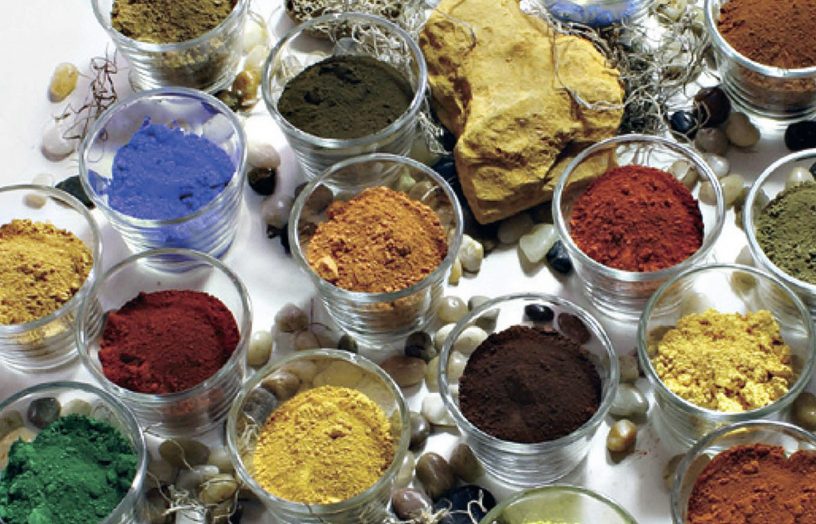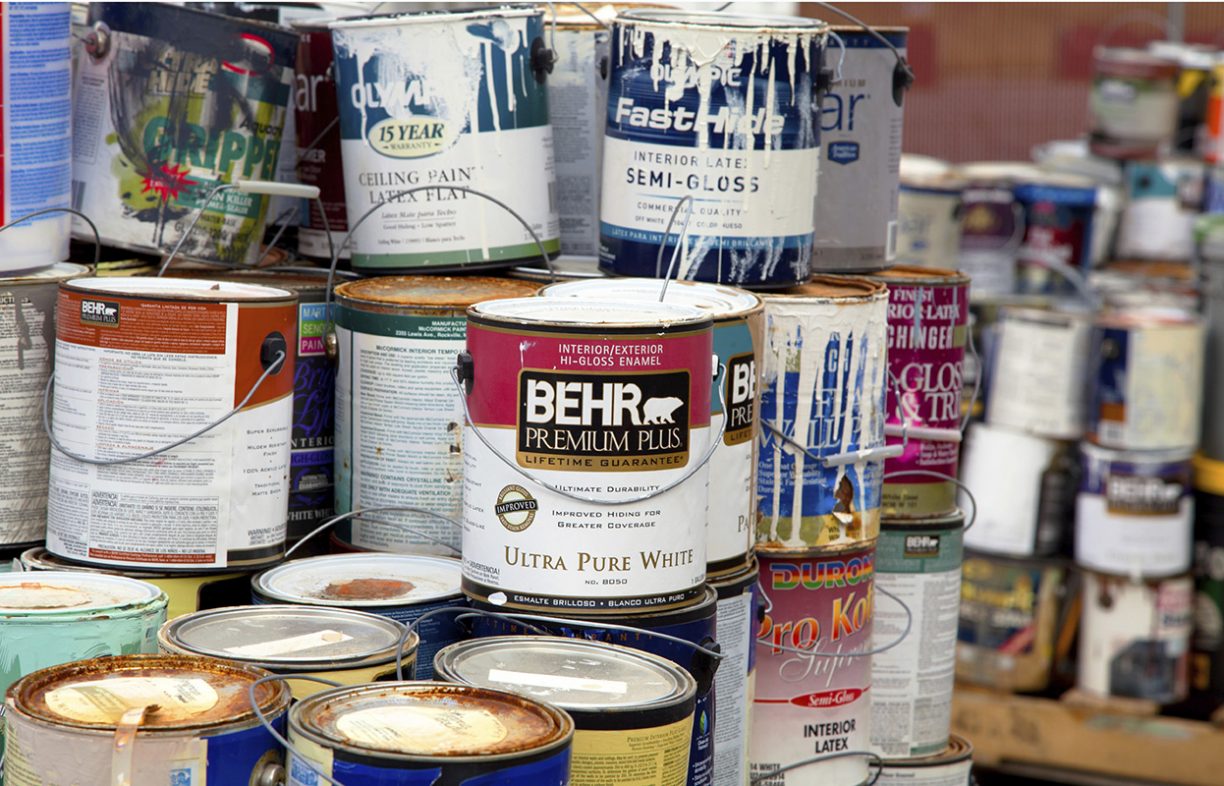An eco-paint buyers guide


Paints have become more eco-friendly in recent years, but there are still traps to look out for. Daniel Wurm explains the advantages of using environmentally friendly paints.
The painting industry has undergone a tremendous transformation over the last 10 years. Back in 2006, I was the only painter in Melbourne to have phased out toxic solvent-based paints. The rest of the industry looked at me as some kind of tree-hugging hippie when I spoke about the dangers of VOCs (volatile organic compounds) to human health and the environment. The last time I wrote for ReNew it was still difficult to find low- and zero-VOC paints, and recycling of waste was a massive issue.
Fast forward to 2016, and I am pleased to say that my industry has taken huge strides down the path of sustainability. It’s a good news story that I am happy to tell. Green is not just a fashion statement: it’s becoming standard practice. Let’s look at some of the developments and see how far we’ve come.
First of all, low-VOC paints now make up the majority of paint sold. Almost all painters have at least tried them and all manufacturers have introduced low-VOC versions of their paints. In many cases, even their cheaper trade lines are now low-VOC. This means that low-VOC paints are available from all paint stores.
In addition, over 500 painters across Australia have been trained to identify and use low-VOC paints, and even apprentices are being taught about them as standard practice. No one argues about the health risks of solvent paints anymore; we all know there are issues and we all want to protect our health.
If any painter tries to tell you that low-VOC or zero-VOC paints will cost more or won’t last, simply walk away and find another painter. If they haven’t got the message yet, they probably never will! Almost all major projects including schools and hospitals now have low-VOC paints specified.
Low-VOC paints are categorised according to their use. For example, the Australian Paint Approval Scheme classes low-VOC low-sheen paints as having less than 5 g per litre of VOCs. We could argue about which standard to use when measuring VOCs, but that is about as interesting as watching paint dry, and VOCs are only part of the issue.
More than VOCs
I prefer to look at the whole-of-life cycle perspective. For example, some manufacturers now offer zero-VOC paints across their range and are independently certified by a recognised eco-label. Why not support these manufacturers, who have shown transparency in their manufacturing process? GECA certification (www.geca.org.au) looks at where the raw materials were sourced and what effect the manufacturing process has on the environment. To me, there is little point in choosing a low-VOC paint if the manufacturer is still producing toxic paint; true sustainability can only be achieved when manufacturers look at it holistically.
Natural paints
Natural paints are paints that are manufactured using the least amount of processing. All paints are made from chemicals, but we now know that the more humans alter raw materials, the higher risk there is of those chemicals affecting our health and the environment. I like to think of natural paints as the ‘bio-dynamic’ products of the painting industry; not everyone wants to use them, they cost more, but they minimise exposure to toxic chemicals. Natural paints are made from ingredients such as linseed oil, minerals, earth pigments, lime and beeswax. They may be a good choice for people with allergies. See the table at the end of this article for a condensed list of suppliers of natural and low-toxicity paints. The full table will be available on the ReNew website at www.renew.org.au/sustainable-houses/136-paint-guide.
I don’t recommend natural paints for exterior applications; the whole point of using paint is to protect a building from premature deterioration and sometimes plastic is the best way to do it!

Exterior painting options
However, if you really desire to use natural paints inside and out, then there are some exterior paint options you may want to consider.
The best natural paints to use outdoors are mineral-based paints, such as Murobond’s Cement Paint. Some of these options can be combined with waterproofing undercoats for a longer lasting and more weatherproof result. However, mineral-based paints do not flex and should only be used on masonry surfaces, never on flexible surfaces such as wood. Although synthetic exterior paints may come with long warranties, even up to 15 years, the expected lifespan of natural mineral-based exterior paints seems to be no more than 10 years, so you should expect to repaint after this time.
A number of manufacturers make natural enamel paints that they rate as suitable for outdoor use. A typical example is the Bio Enamel range from Bio Products, which gives a hard finish suitable for outdoor trims and surfaces. Another exterior enamel is the VINDO Natural Gloss Oil Paint from Livos.
However, while manufacturers state their outdoor suitability, my experience has been that when used outdoors, natural enamels will degrade much faster as they lack the UV inhibitors of synthetic paints. So, I do not recommend natural enamels for outdoor use, but if using them, keep their use to areas which see little sun and weather, or expect to repaint them every few years.
Heat-reflective exterior paints
It’s also important to consider the energy efficiency of the building getting painted. Using a heat-reflective paint will not only give greater longevity, it will also cut cooling costs in summer. Only some heat-reflective paints are what they say they are; look for paints that are CodeMark certified.
Some paints are sold as insulating paints, but a layer of material less than 1 mm thick can’t provide much insulation unless it is reflective. In reality, ‘insulating’ paints are just heat-reflective paints—beware of any paint that claims to provide conductive insulation.
Natural colours
Natural paint colours are usually a little more subdued than synthetic paints, although quite a broad colour palette can be found from a number of the suppliers listed in this guide—although don’t expect to find as extensive a range as with synthetic paints.
Most natural paints are supplied as a white base to which mineral- and plant-based pigments are added, allowing you to produce almost any colour you like, although you generally won’t find very bright colours in these ranges.
Paint application
Generally, natural paints are applied in a similar manner to synthetic paints, using brush, roller or even spraying. Like all paints, you follow the instructions to get a good result, so it’s worth reading up on the best way to apply the particular paint you have in mind to see if it suits your requirements.
Some paints, such as cement paints, are supplied as a powder that you mix with water. You may need to experiment with small quantities of the mixture to find the best consistency for your use, but be patient, the end result of using a natural paint is well worth a bit of extra effort.
Recycling old paint
One of the biggest stories in the painting industry is the introduction of the new Paintback scheme (www.paintback.com.au). This is a collaboration between paint manufacturers, retailers and state governments to introduce a product stewardship program, and it started this year! Paint manufacturers now charge a small levy on all domestic paint sold and this levy is collected and used to pay for a nation-wide recycling scheme. The scheme will make it free for anyone to dispose of waste paint at a collection point. This waste will be sorted and eventually recycled into useful product, closing the loop in the manufacturing process.
Paintback is establishing collection points Australia-wide, starting in major population areas and aiming to have 70 permanent sites over the next three years. It gives do-it-yourself and commercial painters a pathway for unwanted architectural and decorative paint and packaging. It is funded through a 15 cents plus GST per litre levy on eligible products, between 1 litre and 20 litres inclusive. The monies collected will go to Paintback Ltd, which is an independent not-for-profit organisation. Its governing rules ensure that these funds will be used to establish and operate the collection program and research new ways to repurpose unwanted paint materials. Paintback will also fund research to find better uses for unwanted paint.
Waste water from cleaning tools can be a problem when acrylic paints are used. The chemicals in acrylic paints, even zero-VOC brands, are fungicidal and so waste water should not be tipped into stormwater or sewerage systems.
Although the law allows waste water to be discharged on a flat grassy area away from drains, it’s best to hire a painter that has a waste-water treatment unit. There are a number of systems available, and reputable painters, such as accredited GreenPainters, use these systems either on-site or off-site to treat the waste water prior to discharge. This is also better for your garden or vegie patch. No one wants paint chemicals ending up on their organic vegie garden!
Waste water from truly natural paints, on the other hand, is unlikely to contain toxic chemicals and the minerals present might even be good for your garden! Any hardened waste paint can usually be composted.
List of paint manufacturers
See the original article in issue 136 of Renew magazine for a table of companies that produce paints using non-toxic or minimal toxicity materials and/or have an environmental certification. The table was prepared by Renew based on information received from suppliers.
Carrier/solvent/diluent—used to make the paint fluid enough to flow and to carry the other components. It is often a combination of water and solvents.
Pigment—finely ground solid materials (powders) that give the paint its colour. In natural paints, many pigments are metal oxides or plant-derived materials. In synthetic paints, the pigments are often synthetic rather than natural minerals. Note that some pigments can be toxic, such as lead- and cadmium-based pigments. While natural materials, these are most definitely not safe. A type of pigment that is used to provide more bulk and opacity to the paint is called a filler. These include titanium dioxide (common in white paint), although chalk (calcium carbonate), clays and talc are also used.
Resin—also called the binder, this is the acrylic or other material that binds the pigments and other components together to form the paint layer. The binder can be natural or synthetic, and while most household paint binders work by evaporation of the solvents, some rely on chemical reactions from an added catalyst or second paint component. These are most common in industrial use, but may be used in domestic situations on outdoor metalwork or traffic areas.
There are a number of different paint types and each has a different set of characteristics, making it suited for a particular task and not suited to others. Below is a brief rundown of the most common household paints.
Water-borne and water-based
First, a quick explanation of two often interchanged terms, water-borne and water-based. Paints that dry waterproof but can be washed up in water when still wet are correctly called water-borne paints. They consist of the acrylic (or other resins) that will form the final coating, a solvent and water. Once applied, the water and solvent evaporate, leaving the rest to cure to form the paint layer. Water-based is a misnomer for water-borne; this usage seems to have originated from the paints being water-cleanup, to differentiate them from solvent-cleanup paints. True water-based paints can be redissolved in water once dry—watercolour artist paints are an example of a true water-based paint.
Acrylic latex
These are the commonly available water-borne synthetic paints you will find at your local hardware store. Suitable for both indoor and outdoor use (depending on formula), they are mostly synthetic, and while now often being low VOC, they can still have toxic chemicals, and indeed often do. Water-borne polyurethane paints have similar formulations.
Natural resin based paints
These are natural-ingredient paints that contain natural plant-derived resins, making them similar to synthetic acrylic paints in application and final finish. They also contain various minerals for opacity and colour. They may have a matte finish or a sheen with added linseed oil, or a similar oil. Generally used indoors only, may be washable/lightly scrubbable.
Natural mineral-based
These are usually based on cement, plaster and lime minerals. They mostly have a matte finish but may have a sheen with added oil. There is some cross-over between mineral-based paints and natural resin paints as formulations vary. These can be used indoors or outdoors, depending on formula, and may require the use of a sealer or undercoat. Some are specifically designed for outdoor use and will have long lifetimes. Mineral paints are not flexible compared to latex paints, so substrates must not flex or unduly expand and contract. These types of paints are best used on masonry such as brick, concrete and plasterboard. Many mineral-based paints are washable and even scrubbable.
Natural enamels
These can usually be used either indoors or outdoors (with the caveats mentioned earlier) and may or may not contain water as a carrier (water-borne enamels tend to be indoor use only), and so may be called either water-borne or oil-based enamel. They can have high water resistance and are available in matte, satin and gloss versions. They are more flexible than mineral-based paints, so may be suitable for use on wood. They may need to be used on an undercoat or sealer coat.
Synthetic enamels
These are designed for applications similar to natural enamels—outdoor woodwork, detailing and similar uses. They have high levels of UV resistance for outdoor use. They are also more flexible than natural enamels, but like other synthetic paints they may contain toxic VOCs and other chemicals.
Milk paints/casein paints
As their name implies, milk paints usually contain milk, which provides casein, a natural protein. Some casein paints use plant-derived casein, making them arguably more environmentally friendly and more ethical than milk casein paints.
Commercial paint manufacturers have worked to reduce the levels of VOCs in their paints as VOCs, regardless of source, are contributors to smog.
Some VOCs are also quite toxic, so the reduction of VOC levels has come with an added bonus of making paints safer to use. Not all VOCs are toxic, and it varies from paint to paint, but the natural paints tend to contain less toxic VOCs than synthetic paints.
For example, one solvent used in some natural paints is citrus oil, and in particular, D-limonene. While it is a VOC, it is also considered generally non-toxic (you eat citrus peel in fruit cake without ill effect, after all), although it can be an eye and skin irritant in concentrated form. So, the lower the VOCs, of any type, the better.
There is, however, a class of synthetic solvents considered safe and to be a better alternative than even citrus-derived solvents—isoaliphates (also known as non-aromatic compounds). These (mostly) petroleum-derived chemicals are extremely pure and quick to evaporate and dissipate, so do not prolong off-gassing. They are also not absorbed by the human body. A number of natural paint manufacturers use these compounds for the solvent as the least toxic solvent available.
Note though that any chemical that individually makes up less than 1% of the total volume of the paint does not have to be listed in the MSDS (materials safety data sheet), and a single paint product may contain multiple chemicals at less than 1% volume each, although the combined volume of them may be a significant percentage of the whole.
We recommend sticking to natural paints for interior use when possible, although ultimately you need to weigh up all sides of the equation, check the contents of each paint option, and select the option that works best for you—a very low VOC synthetic paint might be a better option than a higher VOC natural paint.
This article was published in issue 136 of Renew magazine. Issue 136 in an Australian-made special.

